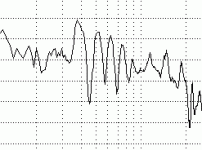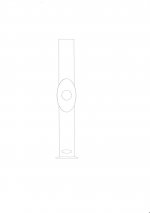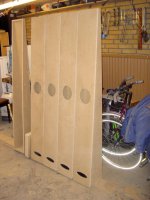Ah. Your SS amp is probably over-damping the drivers (166s?), and you'll be loosing out on the loading with the speakers being 12in out from the wall. Try adding some series resistance -either a 3ohm resistor in the + lead, or junk your existing speaker cable and wire them up with 30AWG magnet wire (makesa some people nervious, but it should do the job).
A suprabaffle would certainly help in thios respect too -get the local tame cabinet maker to turn a couple of disks of hardwood on his lathe with a constantly decreasing radii. About a 14in diameter should do the trick.
A suprabaffle would certainly help in thios respect too -get the local tame cabinet maker to turn a couple of disks of hardwood on his lathe with a constantly decreasing radii. About a 14in diameter should do the trick.
xstephanx said:i have 28 awg magnet wire, which shodul be good enough, but some of the wire inside the cabinet is regular 18 awg, if i use that and teh amgnet wire, the magnet wire will still have the proper effect right?
Yes.
IP -enamalled copper wire. For example: http://www.maplin.co.uk/Module.aspx?ModuleNo=44&criteria=wire&doy=21m2
Hi Scott and Bob,
Thanks for your pointers, it made things quite a bit easier.
I'm quite happy I went down this path, those Abbeys are really something both sound-wise and WAF-wise.
I ended up with 3R9 and 0.82mH
I somehow could not tell the point of adding 1R in series with the whole thing?? Made no difference to me??
Now for step two. I'd like to avoid that round plate that TC has used. What are the options to work around that, but still get the same effect?
Cheers
Magura
Thanks for your pointers, it made things quite a bit easier.
I'm quite happy I went down this path, those Abbeys are really something both sound-wise and WAF-wise.
I ended up with 3R9 and 0.82mH
I somehow could not tell the point of adding 1R in series with the whole thing?? Made no difference to me??
Now for step two. I'd like to avoid that round plate that TC has used. What are the options to work around that, but still get the same effect?
Cheers
Magura
Magura said:I'd like to avoid that round plate that TC has used. What are the options to work around that, but still get the same effect?
ronc said:On the original topic, if you design it correctly you wont need a filter.
I think the round baffle is an important part of the success of this
design. An FE166 in a flat rectangular baffle tends to need a
filter. If you measure the response of the driver in an Abbey you
see a fairly dramatic diffraction effect in the upper midband where
you would ordinarily think to apply a filter. Non-intuitively,
this appears to sonically smooth out the upper midrange, and
creates a pleasing sonic signature for the Abbeys not found in
more conventional designs.
Attachments
MJK said:Chris,
I think that paper is complete BS. Gee, a guy who sells tube amps is writing a paper bashing solid state. Big surprise. Do you really think that is a fair assessment?
Agreed. Complete tosh. The fellow doesn't understand valve amplifiers, either. The sooner the term "damping factor" is leaned up against the wall and shot, the better. It's output resistance that is the important thing, and it needs to be correct for the particular loudspeaker/box combination.
I am not sure if the baffle respons will change, with a much different baffle? I suspect it would. I think its a safe bet to go for the original circular baffle, but its easy enough to try out. I guess the Danish DIY'ers went Abby banana'sdon't no if it should be a little longer about 550 mm to make it look more like the porthole
Steen
Attachments
EC8010 said:
Agreed. Complete tosh. The fellow doesn't understand valve amplifiers, either. The sooner the term "damping factor" is leaned up against the wall and shot, the better. It's output resistance that is the important thing, and it needs to be correct for the particular loudspeaker/box combination.
Thanks to both gentlemen.
FWIW, my intended point in linking to the DF treatise was exactly that "correction" ( passive filters, EQ networks or whatever mechanism of choice), must carefully consider the dynamics of the offending component(s) - some of which are more than a little complicated for the average non-technically proficient (myself at the top of that list)
I'll further endear myself to the experts
 by offering that some latitude should be considered for individual subjective evaluation of the results.
by offering that some latitude should be considered for individual subjective evaluation of the results.I think the round baffle is an important part of the success of this
design. An FE166 in a flat rectangular baffle tends to need a
filter. If you measure the response of the driver in an Abbey you
see a fairly dramatic diffraction effect in the upper midband where
you would ordinarily think to apply a filter. Non-intuitively,
this appears to sonically smooth out the upper midrange, and
creates a pleasing sonic signature for the Abbeys not found in
more conventional designs.
I agree. If you take the time and effortin the design stage you can " balance out" the inherent diffraction with the FR curve. The only reason i went with the design on the Austin series that i did was ease of build to the average DIYer. However a round baffle will produce a more spherical wavefront. If the radi on the circumference is shaped correctly then the later timed secondary waves can be tuned for the natural FR curve.
ron
design. An FE166 in a flat rectangular baffle tends to need a
filter. If you measure the response of the driver in an Abbey you
see a fairly dramatic diffraction effect in the upper midband where
you would ordinarily think to apply a filter. Non-intuitively,
this appears to sonically smooth out the upper midrange, and
creates a pleasing sonic signature for the Abbeys not found in
more conventional designs.
I agree. If you take the time and effortin the design stage you can " balance out" the inherent diffraction with the FR curve. The only reason i went with the design on the Austin series that i did was ease of build to the average DIYer. However a round baffle will produce a more spherical wavefront. If the radi on the circumference is shaped correctly then the later timed secondary waves can be tuned for the natural FR curve.
ron
ROVSING said:Nice looking kabinets after my humble opininon, i think i'll make a pair or two of them this weekend
Hmm, autoreview.....
Did you get around to making the last two for yourself and Steenoe ?
Magura
- Status
- This old topic is closed. If you want to reopen this topic, contact a moderator using the "Report Post" button.
- Home
- Loudspeakers
- Full Range
- Filter for Abbeys and Fostex FE166



